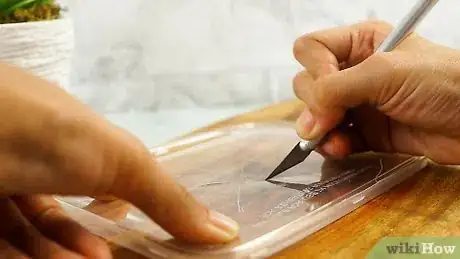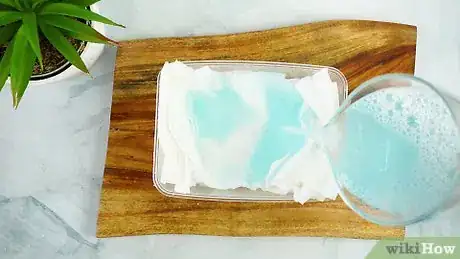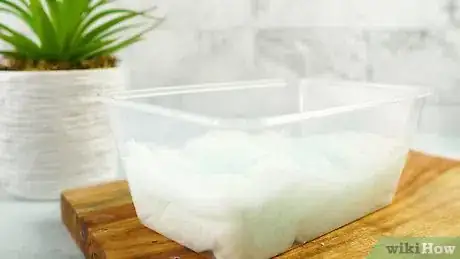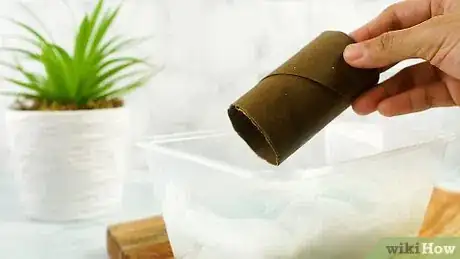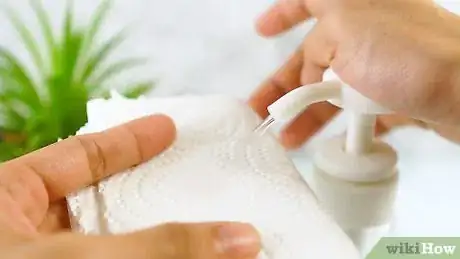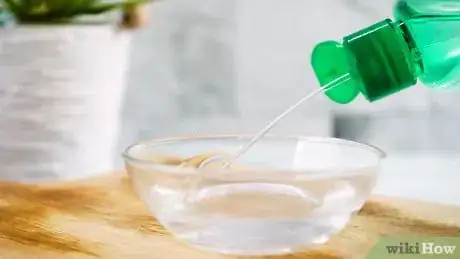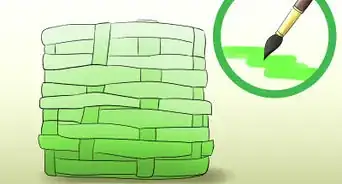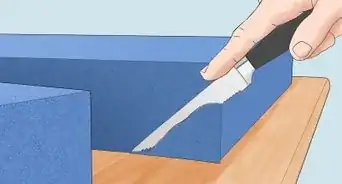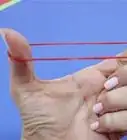This article was co-authored by wikiHow staff writer, Megaera Lorenz, PhD. Megaera Lorenz is an Egyptologist and Writer with over 20 years of experience in public education. In 2017, she graduated with her PhD in Egyptology from The University of Chicago, where she served for several years as a content advisor and program facilitator for the Oriental Institute Museum’s Public Education office. She has also developed and taught Egyptology courses at The University of Chicago and Loyola University Chicago.
There are 7 references cited in this article, which can be found at the bottom of the page.
The wikiHow Video Team also followed the article's instructions and verified that they work.
This article has been viewed 19,951 times.
Learn more...
If you can’t wash your hands with soap and water, using an alcohol-based hand sanitizer that’s at least 60% alcohol is a good alternative for killing germs and viruses on your hands.[1] While you can just rub a little gel sanitizer onto your hands to clean them, researchers have found that hand sanitizing wipes work even better, since they actually wipe away germs and dirt. While disinfectant wipes can be hard to find in stores, especially during the coronavirus outbreak, you can easily make your own with some hand sanitizer and a few basic household supplies!
Steps
Making Wipes with Commercial Hand Sanitizer
-
1Slice a slit shaped like an X in the lid of a plastic food storage tub. Find a plastic food storage container that’s the right width to hold part of a roll of paper towels. Use a precision knife or box cutter to slice an X shape into the center of the lid. You’ll use this opening to pull the wipes out through the lid of the container.
- Set the lid down on a flat, hard surface that won’t be damaged if you scrape it with your blade, such as a cutting board or work bench. Be careful to keep your fingers out of the way!
Tip: Alternatively, you can use a refillable baby wipe dispensing tub and individual paper towel sheets instead of a roll.
-
2Cut a section of a paper towel roll so it will fit in the tub. Take a sturdy roll of paper towels and lay it down on its side on a cutting board. Hold the roll firmly and saw through it width-wise with a sharp, serrated knife. You want the section you cut to be short enough to fit in your plastic tub standing upright.
- You may find it easier to make a clean cut with a band saw, if you have one.
Advertisement -
3Put the paper towel section in your plastic tub. Take the cut section of paper towel and set it upright in the container, with the cut side down. The section should be short enough that it fits inside with the lid tightly closed.[2]
- If you can’t close the container tightly with the paper towels inside, your hand sanitizer will evaporate and the towels will dry out.
-
4Pour 1 cup (240 mL) of alcohol-based hand sanitizer over the paper towels. According to the Centers for Disease Control and Prevention, sanitizers that are at least 60% alcohol are the most effective at getting rid of bacteria and viruses on your hands.[3] Measure out 1 cup (240 mL) of your hand sanitizer and pour it into the container.
- Move the container with the sanitizer in it around as you pour so that you cover the paper towels as much as possible.[4]
- Since hand sanitizer is a thick liquid, you might need to experiment with using more of it to saturate your paper towels completely.
-
5Let the paper towels soak in the hand sanitizer for a few hours. Cover the container and set it aside. Allow the paper towels to sit for several hours or overnight so they can absorb the hand sanitizer thoroughly.
-
6Slide the cardboard tube out of the middle of the roll. When the paper towels have soaked up all the hand sanitizer, the cardboard tube in the center of the roll should be soft and damp. Pinch the end of it with your fingers or a pair of tongs and carefully slide it out.[7]
- Throw away the cardboard tube after you remove it from the roll.
- Taking out the tube will allow you to pull individual sheets out of the middle of the roll and use them as hand wipes.
-
7Pull the inner end of the paper towel roll through the cut in the lid. The center part of the paper towel roll should poke up after you remove the cardboard tube from the roll. Grab the end of the sheet sticking out of the middle of the roll and gently pull it through the x-shaped slit that you made in the lid of the plastic tub. Close the lid tightly with the end of the roll of paper towels sticking out through the slit.
- You can now pull a wipe out of the tub whenever you need it, and the rest of the wipes will stay moist inside the container!
-
8Rub all surfaces of your hands carefully to disinfect them. Pull a wipe out of the tub and use it to wipe every surface of your hands, including your palms, the backs of your hands, and the spaces between your fingers. You can also use the wipes to clean beneath your fingernails. Use more than one wipe if you have to.[8]
- Keep wiping until your hands are visibly clean.
- Allow your hands to air dry when you’re done. Don’t wipe or rinse away the sanitizer, since it will be less effective if you remove it from your hands too quickly.
- Throw away any used wipes immediately in a lined trash can.
Mixing Your Own Hand Sanitizer
-
1Don’t make your own hand sanitizer unless you have no alternative. According to the CDC, washing with soap and water is the most effective way to clean bacteria, viruses, and toxins off of your hands. However, if you don’t have soap and water, an alcohol-based commercial hand sanitizer that’s at least 60% alcohol is a good alternative.[9] It’s very difficult to make your own hand sanitizer that’s likely to be both effective and safe for your skin, so avoid turning to DIY solutions unless you have no other option.
- In addition to containing at least 60% alcohol, your DIY hand sanitizer will need a moisturizing component to prevent the alcohol from damaging your skin. It’s very tricky to get the proportions correct when mixing these ingredients.
-
2Get some 99.8% isopropyl alcohol or 96% ethanol as a base for your sanitizer. Isopropyl alcohol and ethanol are both very effective disinfectants, and both are on the EPA’s list of products that can kill the coronavirus.[10] To make an effective DIY hand sanitizer, you’ll need a very strong concentration, such as 99.8% isopropyl alcohol or 96% ethanol. You can purchase these products online or from a science supply store.
- It’s hard to find such strong concentrations of alcohol at most drug stores. Isopropyl alcohol is usually sold in a 70% concentration, which won’t be strong enough to be effective once you mix it with a moisturizer.
Warning: While you may have heard that you can use vodka or other forms of alcohol as a hand sanitizer, the concentration of ethanol in these beverages is typically not strong enough to be effective. You’d need an alcohol that’s at least 180 proof to make an effective DIY hand sanitizer.[11]
-
3Combine 2 parts alcohol with 1 part pure aloe vera gel. Place the alcohol and aloe in a clean container and mix it together until you have a well-blended gel. Make sure to use a ratio of at least 2 parts alcohol and 1 part aloe in order to get a high enough concentration of alcohol in your final product. You can purchase aloe gel in a drug store or online, or harvest it directly from an aloe plant.[12]
- For example, you can mix 2⁄3 cup (160 mL) of alcohol with 1⁄3 cup (79 mL) aloe vera gel to create 1 cup (240 mL) of hand sanitizer.
- If you like, you can also add 2-3 drops of your favorite essential oil to give it a pleasant scent.
- As an alternative to aloe, you can use 98% glycerol as the moisturizing component, which is recommended by the World Health Organization.
-
4Put your DIY hand sanitizer in a clean plastic container. Once you’ve made your gel, place it in a clean squeeze bottle or soap dispenser.[13] If you want to use it on a wipe, pump a little onto a tissue or paper towel and wipe your hands with it.[14]
- Alternatively, you can create wipes by soaking a roll of paper towels with your sanitizer and keeping them in a plastic tub. Pull out a sheet whenever you need to use it.
-
5Follow the WHO guidelines to make a large batch of sanitizer. If commercial hand sanitizer isn’t available where you live, you can create your own in larger batches following the World Health Organization’s recipe. To do this properly, you’ll need the following specialized ingredients and equipment:
- 8,333 millilitres (35.22 c) of 96% ethanol or 7,515 millilitres (31.76 c) of 99.8% isopropyl alcohol
- 417 millilitres (1.76 c) of 3% hydrogen peroxide
- 145 millilitres (0.61 c) of 98% glycerol
- Sterile boiled or distilled cold water for rinsing your equipment
- A large plastic bottle or tank with graduated volume markers and a lid you can seal tightly
- A large plastic or metal funnel
- Graduated measuring cups or cylinders
- Small plastic storage bottles for storing the mixture
- Alcoholmeters for confirming the concentration of the alcohol
Things You’ll Need
Making Wipes with Commercial Hand Sanitizer
- Plastic food storage container with a lid
- Precision knife or box cutter
- Roll of paper towels
- Serrated kitchen knife or band saw
- Alcohol-based hand sanitizer (at least 60% alcohol)
Mixing Your Own Hand Sanitizer
- 99.8% isopropyl alcohol or 96% ethanol
- 100% aloe vera gel or 98% glycerol
- Plastic bottle or soap dispenser
- Paper towels or tissues
Warnings
- Always keep alcohol-based hand sanitizers out of reach of children. Ingesting even a small amount can cause alcohol poisoning.[15]⧼thumbs_response⧽
- Using soap and water is always preferable to cleaning your hands with hand sanitizer. Use hand sanitizer only if soap and water aren’t readily available, and stick to using commercial hand sanitizers instead of DIY ones unless you have no choice.[16]⧼thumbs_response⧽
References
- ↑ https://www.cdc.gov/handwashing/show-me-the-science-hand-sanitizer.html
- ↑ https://www.thekitchn.com/how-to-make-wet-wipes-from-paper-towels-229046
- ↑ https://www.cdc.gov/handwashing/show-me-the-science-hand-sanitizer.html
- ↑ https://www.thekitchn.com/how-to-make-wet-wipes-from-paper-towels-229046
- ↑ https://www.thekitchn.com/how-to-make-wet-wipes-from-paper-towels-229046
- ↑ https://www.cdc.gov/handwashing/show-me-the-science-hand-sanitizer.html
- ↑ https://www.thekitchn.com/how-to-make-wet-wipes-from-paper-towels-229046
- ↑ https://www.cleaninginstitute.org/cleaning-tips/hands/hand-sanitizers
- ↑ https://www.cdc.gov/handwashing/show-me-the-science-hand-sanitizer.html
- ↑ https://www.epa.gov/pesticide-registration/list-n-disinfectants-use-against-sars-cov-2
- ↑ https://www.usatoday.com/story/money/2020/03/05/coronavirus-prevention-vodka-homemade-hand-sanitizer-titos/4966724002/
- ↑ https://www.theverge.com/2020/3/2/21161346/hand-sanitizer-diy-how-to-hand-wash-cdc-alcohol-virus-illness
- ↑ https://www.theverge.com/2020/3/2/21161346/hand-sanitizer-diy-how-to-hand-wash-cdc-alcohol-virus-illness
- ↑ https://www.businessinsider.com/coronavirus-how-to-make-hand-sanitizer-and-cleaning-wipes-2020-3
- ↑ https://www.cdc.gov/handwashing/show-me-the-science-hand-sanitizer.html
- ↑ https://www.cdc.gov/handwashing/show-me-the-science-hand-sanitizer.html
About This Article
To make your own disinfectant hand wipes, first mix ⅔ cup (160 mL) of 99% rubbing alcohol and ⅓ cup (80 mL) of aloe vera gel. The rubbing alcohol will kill germs and viruses on your hands, and the aloe vera gel will help keep your hands moisturized. Pour the mixture into a clean plastic container and close the lid tightly. When you’re ready to use a hand wipe, squeeze some of the disinfectant onto a paper towel or tissue. Then, wipe your hands thoroughly and let them air dry.
